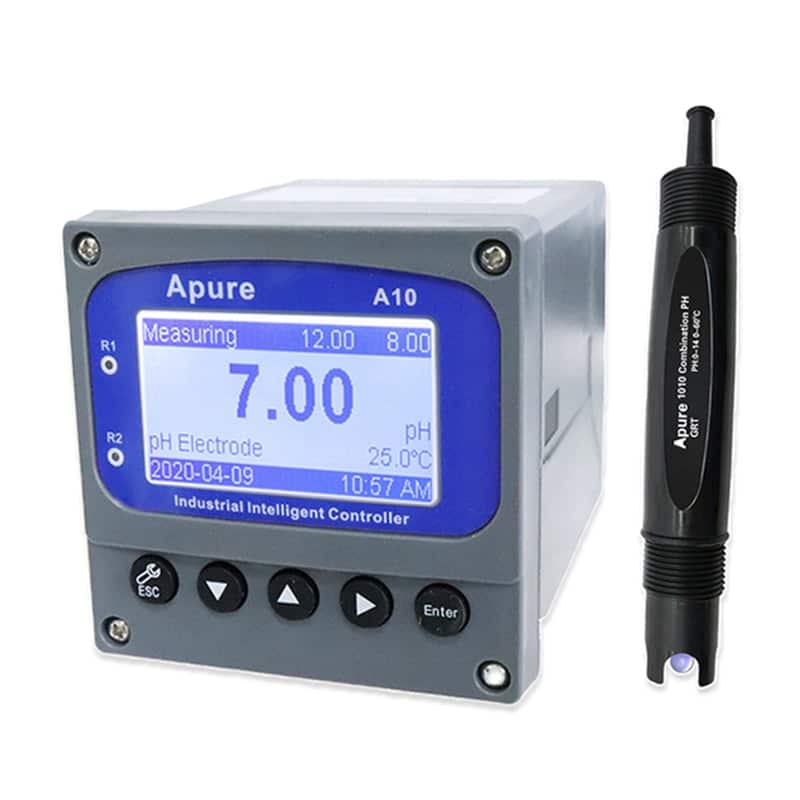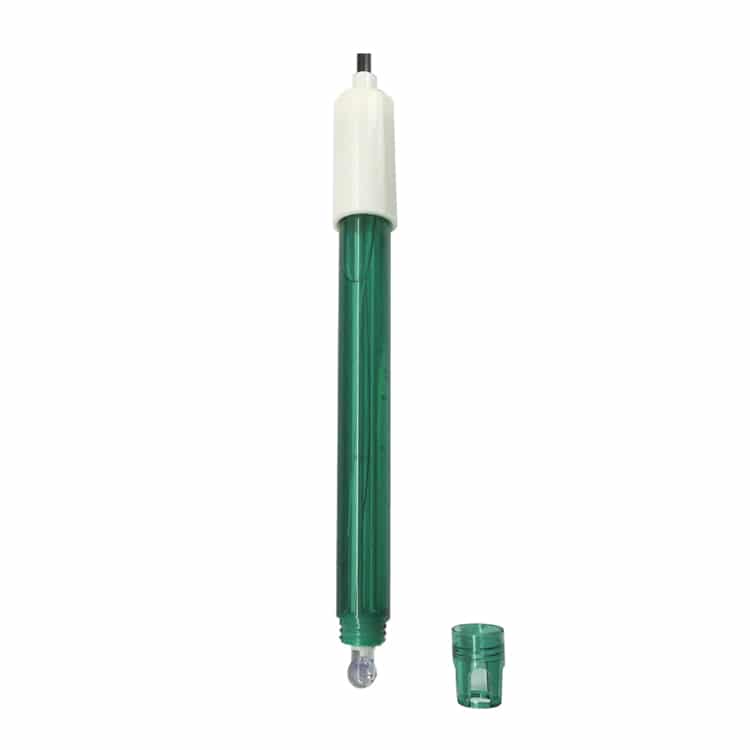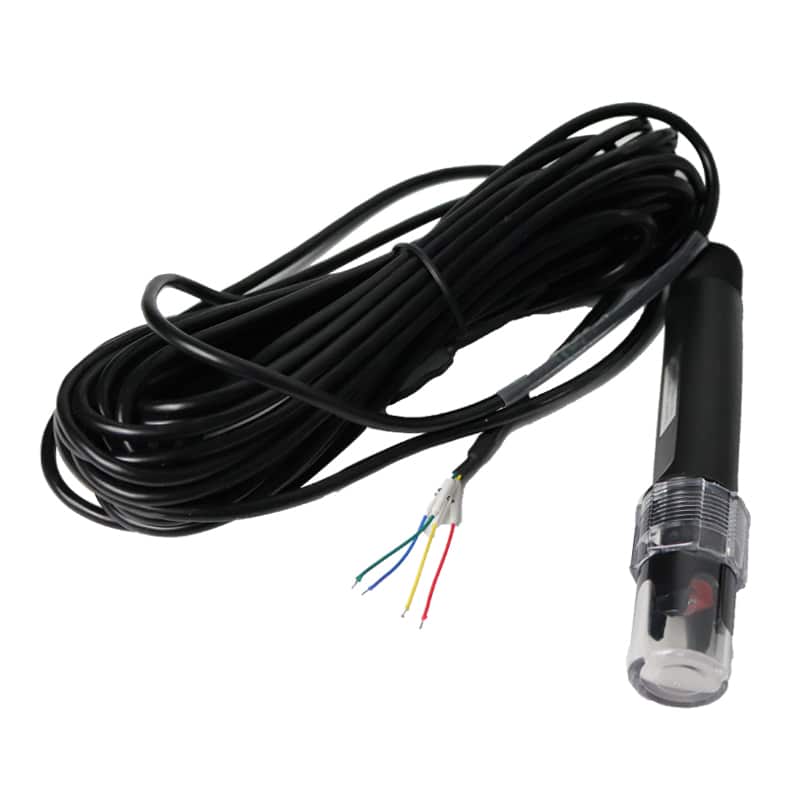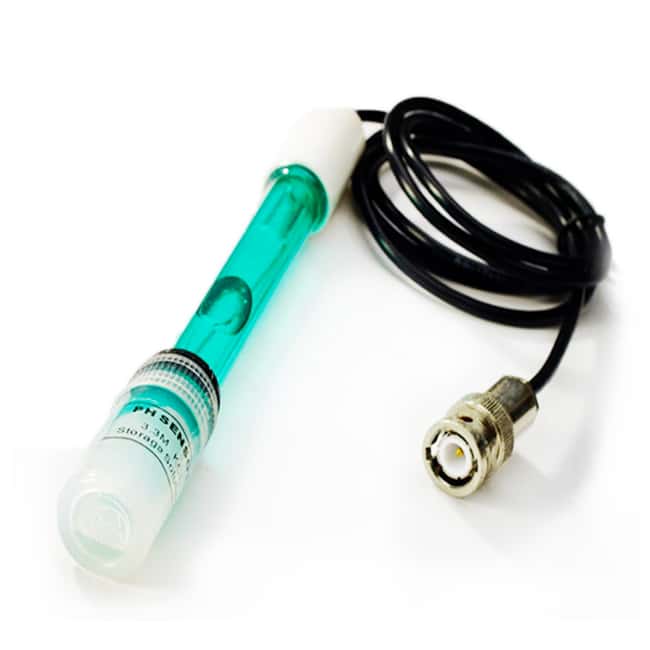What is a ph probe?
pH probe contains two electrodes (a sensor electrode and a reference electrode) to measure the hydrogen ion activity in the solution. The ion exchange generates a voltage, which is measured by a pH meter that converts the voltage to a readable pH value. It is a water quality sensor that measures the pH level of a liquid.
pH (hydrogen potential) measures the interaction between hydrogen and hydroxide ions in a water-based solution. Solutions with large amounts of hydrogen ion activity are acids. Conversely, a solution with a large amount of hydroxide ion activity is a base.
The use of pH probes in measuring pH is important for a wide range of industries, which is why there are different pH sensors for different applications. Next we will learn how pH probes work, what pH sensors measure, and what is inside a pH probe.
How do ph probes work?
The common practice of measuring the pH of a solution is to use litmus paper. It turns a different color depending on the pH chart without considering the hydrogen ion content, however, a pH meter must use a pH probe to measure the hydrogen ion concentration.
A pH meter works by measuring the electrical potential (voltage) generated by the solution being measured and using the potential difference to determine the pH value. Acidic solutions have more positively charged hydrogen ions than alkaline solutions, and therefore, the solution has a greater potential to produce a current.
A pH meter consists of three components: the pH meter itself (moving coil or digital meter), the pH electrode, and the pH probe inserted into the solution being measured.
Most pH probes contain two electrodes in the body: a measuring electrode (glass electrode) and a reference electrode. The glass electrode contains the reference electrolyte (usually potassium chloride), which has a neutral pH of 7, so it contains a specific amount of hydrogen ions.
The glass electrode works by measuring the difference in pH between the pH electrode and the solution under test. The electrode does this by measuring the voltage difference between the electrode and the hydrogen ions produced in the solution. This is easily solved because we already know the pH value of the glass electrode combination.

What does a pH probe measure?
A pH meter uses a pH probe to measure the acidity or alkalinity (hydrogen ion activity) of a solution, expressed as a pH value. The pH of a solution is related to the ratio of hydrogen ions in the pH probe and the solution being measured.
When you immerse the pH probe in a solution, many of the hydrogen ions move toward the glass electrode, replacing some of the metal ions inside, and some of the hydrogen ions disperse into the solution being measured. This ion exchange process is called ion exchange and is the main principle behind how the glass electrode inside the pH probe works.
Ion exchange also occurs on the inner surface of the glass electrode. Since the acidity of the potassium chloride inside the electrode and the solution being measured are different, the activity of the hydrogen ions will be different, resulting in a difference in charge. When this happens, a potential difference occurs between the sides of the glass electrode and the reference electrode, which produces a pH reading on the meter.
Although the meter measures the voltage, the digital display shows it as a pH measurement. It makes calculations based on the voltage difference; the greater the voltage between the pH probe (electrode) and the solution being measured, the greater the difference in hydrogen ion activity. The more hydrogen ion activity that occurs, the lower the pH value, and vice versa.
Before using a pH meter, it is important to calibrate it for accurate results and is an important part of general electrode maintenance. We recommend that you follow our recommendations for pH probe calibration to always ensure that your pH readings are reliable.
In order to understand more about the function of the pH Probe, we need to understand how the pH electrode inside the pH probe works.
How does a pH electrode work?
There are several types of pH electrodes for industrial and laboratory applications, however, most of them are made of glass and therefore break easily and need to be hydrated. That is why we ship each pH probe in a plastic immersion bottle with a pH probe storage solution.
The first pH electrode invented consisted of a glass bulb filled with a strong electrolyte and an internal silver/silver chloride (Ag/AgCl) half-cell and a silver wire in contact with the external solution.
The general working principle of pH electrodes has not changed much, but as technology has advanced, combination and double junction electrodes are more commonly used.
Combination electrodes
Combination electrodes measure both sides of a glass electrode and are the most common of the pH probes. pH probes require an electrode with a closed circuit to measure the potential passing through the electrode’s internal solution (e.g., potassium chloride), the external solution being measured, and the pH meter completion.
When the electrode is immersed in the test solution, it recognizes the positive charge of the hydrogen ion in millivolts (mV) and transmits a signal to the internal electrode. silver wire inside the pH probe transmits the electrical signal to the electrode cable connected to the pH meter.
Components of a pH probe
Most pH probes contain a glass hydrogen ion sensitive electrode and a reference electrode, called a combination electrode. A common pH electrode consists of several structures.

- Electrode body
- Glass membrane
- Reference electrode
- Reference electrolyte
- Reference junction
Electrodes
The electrode body can be plastic or glass, so when you hear the term “glass electrode,” it refers to the membrane material, not the external electrode body.
Apure offers two main types of pH probe bodies.
- Laboratory grade pH probes: Extruded epoxy bodies, making them incredibly resistant to strong acids and bases.
- Industrial pH probes: The sensor body makes it chemically inert and virtually indestructible.
Glass Membrane
A glass membrane is a pH-sensitive membrane filled with a buffer solution that is located inside the glass electrode of a pH probe.
The membrane allows hydrogen ions to continuously bind within the membrane while the outside of the glass membrane is exposed to the sample being measured. It is the difference in hydrogen ions across the membrane that generates the voltage potential.
The shape of the membrane can vary depending on the application. Some applications require pH probes with specialized membranes that can be used to pierce semi-solid media, such as spear-tip pH probes.
Reference Electrode
A reference electrode is required to provide a constant potential within the pH probe to determine pH.
The most common type of reference electrode contains silver/silver chloride (Ag/AgCl), which is used in a variety of applications including the medical and food industries because it is non-toxic to humans.
Reference electrodes containing mercury chloride (Hg/Hg2Cl2) are still used in some industries, but are not commonly used due to the toxicity of mercury.
The latest reference systems to be developed contain iodine due to fast response times and low temperature sensitivity. When measuring the pH of tris buffers and protein solutions, the iodine reference system is usually used because it is a metal ion-free system; reference electrodes containing metal ions (e.g. Ag/AgCl) can interact with the solution and thus block the reference contact.
Reference Electrolyte
The reference electrolyte closes the circuit inside the pH probe electrode. The electrolyte must be chemically neutral and have good conductivity to work properly.
Different diffusion rates of hydrogen ions in the electrolyte solution can create potentials that can cause problems when measuring pH, so the fluidity of the electrolyte solution is also important.
The most common reference electrolyte solution is potassium chloride (KCl), however, KCl is not recommended for measuring pH in low temperature solutions because it will crystallize inside the pH probe.
Reference Junction
Also known as a septum, the reference junction is a porous communication point that generates a current between the reference electrode and the sample being measured.
Different reference junctions have different discharge rates, depending on the application you are using. Double junction electrodes are used to operate under unfavorable conditions in applications where reverse electrolyte flow may occur. Reverse electrolyte flow may occur when the solution under test is acidic or alkaline, or when it is under extreme pressure or has extremely high temperatures.
The double junction electrode protects the reference junction from contamination because the solution under test must diffuse through both joints before the pH value can be recorded.
Are pH probes and pH meters the same?
A pH probe is part of a pH meter, so technically they are not the same, however, they would not function without each other.
A pH meter consists of three parts: the pH probe, the reference pH electrode, and the pH meter itself. It is the electrode inside the pH probe that measures the pH value of the solution.
The pH probe records the voltage of the hydrogen ion and converts the voltage into a readable pH value for the pH meter by measuring the difference between the electrode inside the pH probe and the reference electrode.
The pH probe is connected to the pH meter display panel to show the measured pH value. At Apure, our pH probes can also be connected into a pipe, called “mounting the probe in the pipe”.
Apure pH sensor probe products
Summary
The pH probe works depending on the exchange of hydrogen ions that generate the voltage.
The glass electrode inside the pH Probe measures the difference in pH between the pH electrode and the solution you are testing. The electrode does this by measuring the difference in voltage between the electrode and the hydrogen ions produced in the solution. It is the pH meter that converts this voltage into a readable pH value.
If you have any questions about pH or are unsure which pH probe is best for your needs, or need additional instruments for water quality monitoring, please feel free to contact Apure’s expert team.
More articles on pH probes:
What is ORP?
What is salinity?
How to maintain ph level for hydroponics
Solution of water pollution


